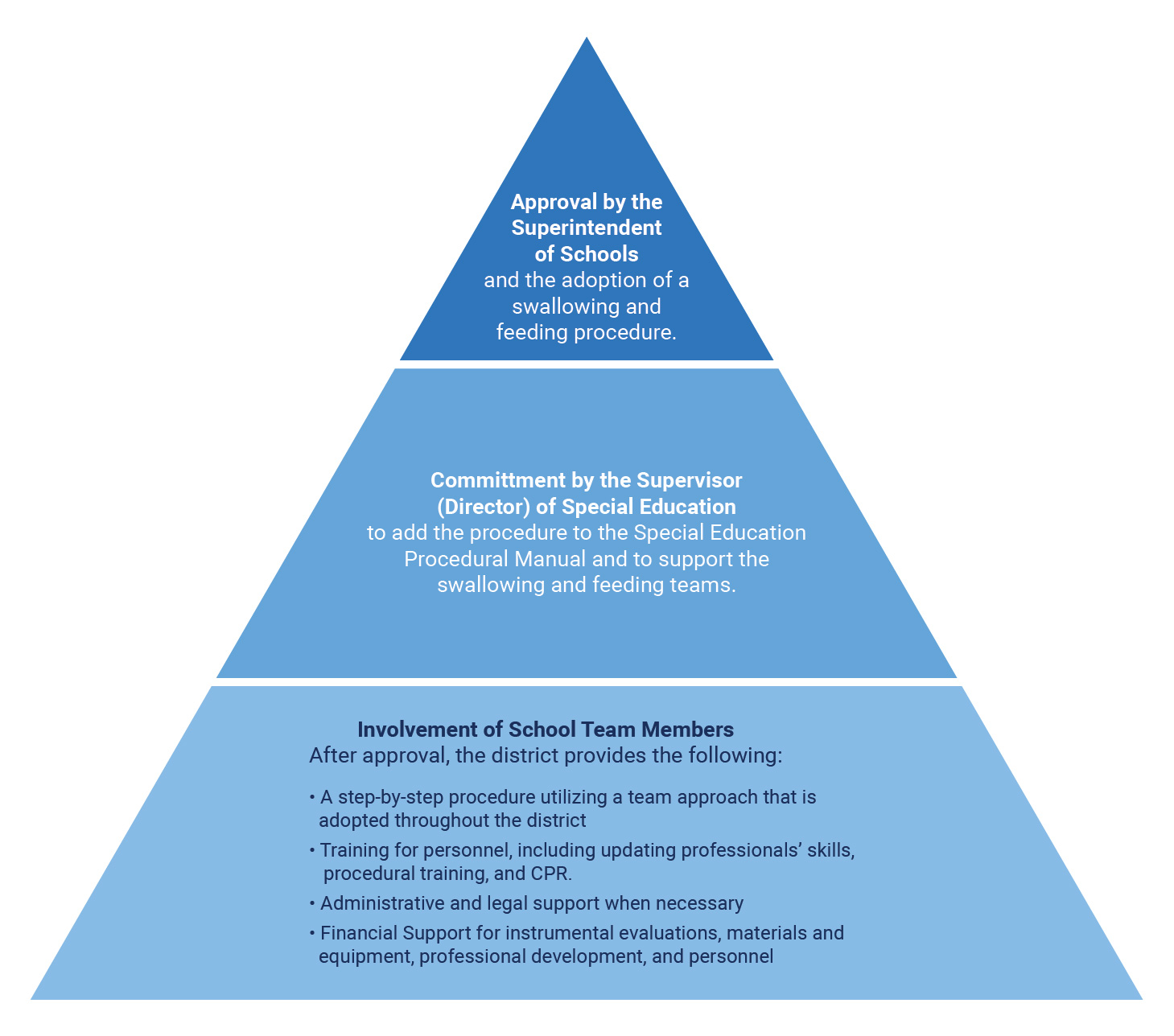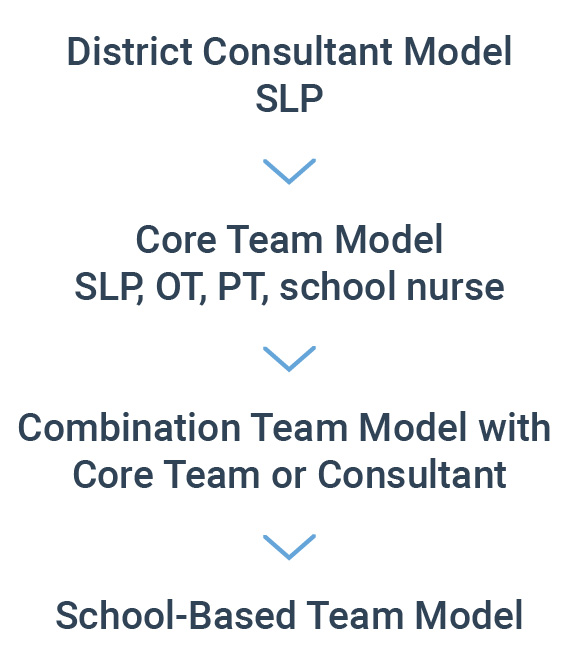Swallowing & Feeding in the School Setting: How to Secure Administrative Support

Have you noticed students in your schools with the signs and symptoms of a swallowing and feeding disorder? Maybe you informed your supervisors, but they didn’t seem concerned. What should you do in this situation?
School administrators often don’t understand swallowing and feeding disorders, their risk factors, or the incidence of school students. They may also not be aware of federal regulations and legal mandates that require them to address it.
Let’s talk about what you as a school speech-language pathologist can do to make a swallowing and feeding procedure part of the special education procedures in your district and how to get that crucial administrative buy-in.
5 Reasons Why School Districts Must Address Swallowing and Feeding
Why is it necessary for a school district to approve a step-by-step procedure for addressing swallowing and feeding?
- Schools must establish safe feeding for students with swallowing and feeding disorders. Students must be able to eat safely and efficiently at school so that they can have adequate nutrition and hydration to access their curriculum and succeed as students.
- Schools must follow federal regulations that are part of the Individuals with Disabilities Education Act (IDEA) and the provision of a free and appropriate public education (FAPE). Health is a related service under IDEA, providing services that are necessary for a student to be able to remain in school when those services require a school nurse or other qualified professional. IDEA also requires that school districts take the necessary steps to prevent foreseeable harm when students are at school or on school property, including during mealtimes.
- Schools must comply with legal mandates. These mandates include two Supreme Court cases requiring health services as well as several state legal decisions that set precedent for holding districts responsible for safety during mealtimes at school.
- Schools must comply with the code of ethics for school district professionals to look out for student well-being. This includes SLPs, occupational therapists, physical therapists, and school nurses.
- Schools must follow federal United States Department of Agriculture’s (USDA) regulations regarding food service programs at school.
What Is a Top-Down Model for Swallowing and Feeding?
A top-down approach means that the school district has adopted a swallowing and feeding procedure that is used throughout the district with any student at risk.
To achieve this, it is essential for SLPs to:
- Secure administrative support
- Use a step-by-step, comprehensive procedure
- Use a team approach with defined roles and responsibilities
Many SLPs and other school-based professionals have the knowledge and skills to address swallowing and feeding, so why can’t they just start doing it?
Because swallowing and feeding disorders are complex, the support and commitment of the school district is essential—especially when there are questions and concerns from parents.

Getting Upper Administration on Board
So how does a professional in a school district go about convincing administration that there is a need for an added service?
You will have to provide upper administration with information that helps them make informed decisions. Anticipate questions and have answers prepared ahead of time.
When preparing a proposal, the following process should be followed:
- Engage other professionals, including SLPs, OTs, PTs, and school nurses who may have similar concerns and are the most knowledgeable.
- Discuss with your immediate supervisors the need for a swallowing and feeding procedure, stressing legal, ethical, and regulatory concerns as well as your interest in establishing a committee to investigate establishing a team procedure.
- Form the committee.
- Meet with committee members to organize a proposal to present to the Supervisor of Special Education.
At this point, you can move forward with the actual proposal creation:
1. Determine which committee members will be responsible for preparing the proposal. This should include a variety of school-based professionals.
2. Commit to a team approach, with each team having a trained and experienced SLP assigned to it.
3. Choose a team model, with a plan of how to implement it as part of your proposal. The model chosen depends on the number of trained and experienced SLPs in the district.
These are some examples of team models you might choose, based on the professionals available:

4. Identify the training needs of your professional staff. For instance, how many district SLPs need to update their skills? MedBridge courses can help address any skill deficits, such as:
- Addressing Behavior and/or Sensorimotor Feeding Disorders in Schools
- Management & Treatment of Swallowing & Feeding Disorders in Schools
- Childhood Assessment of Normal & Dysfunctional Feeding & Swallowing
- Treatment of Children with Dysphagia
5. Get an estimate of the number of students in the district who are at risk by surveying SLPs, OTs, and classroom teachers.
6. Identify and estimate potential expenses, including training, instrumental evaluations, materials, and equipment. If indicated, include any additional necessary personnel.
7. Summarize the procedure recommended by the committee, including the essential steps and suggested forms.
8. Inform administration of the need for the Food Services Program to provide the recommended food modifications for students.
While addressing swallowing and feeding can be a complex and complicated process, this top-down model will provide consistency, accountability, documentation, safety, and support. Having a district-approved procedure in place allows all students with swallowing and feeding concerns to receive the services they need to have safe and efficient mealtimes at school.
- American Speech-Language-Hearing Association. (2003). Code of ethics (revised). ASHA Supplement, 23, 13–15.
- Individuals with Disabilities Education Improvement Act, 20 Rehabilitation Act of 1973, 29 U.S.C. § 701 et seq. (1973).
- Homer, E. (2009). Issues of management of swallowing and feeding disorders in the school setting. Perspectives on Swallowing and Swallowing Disorders, 18(3), 80–85. https://doi.org/10.1044/sasd18.3.80
- Power-deFur, L., & Alley, N. S. N.(2008). Legal and financial issues associated with providing services in the schools to children with swallowing and feeding disorders. Language, Speech, and Hearing Services in Schools, 39(2), 158–166. https://doi.org/10.1044/0161-1461(2008/016)




